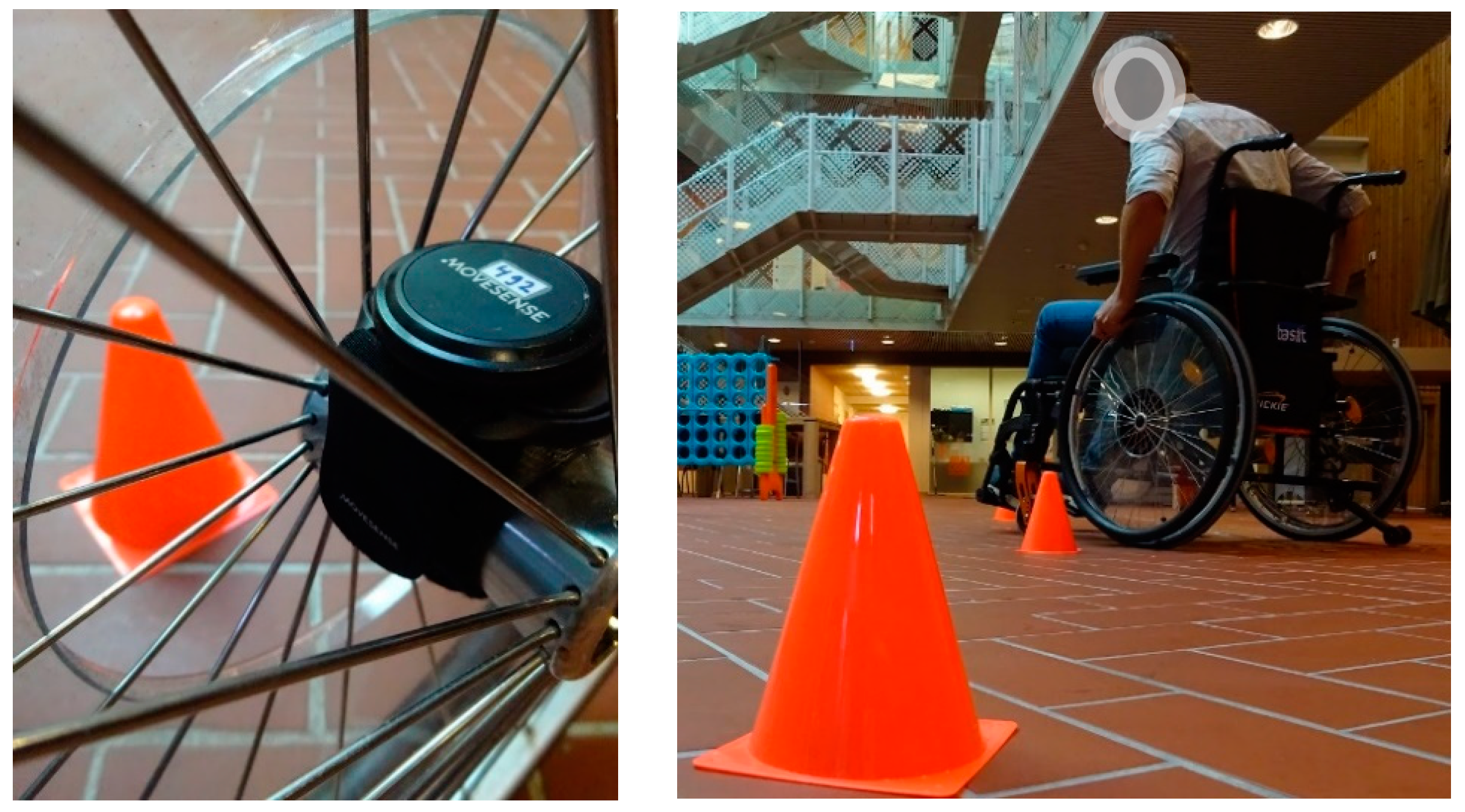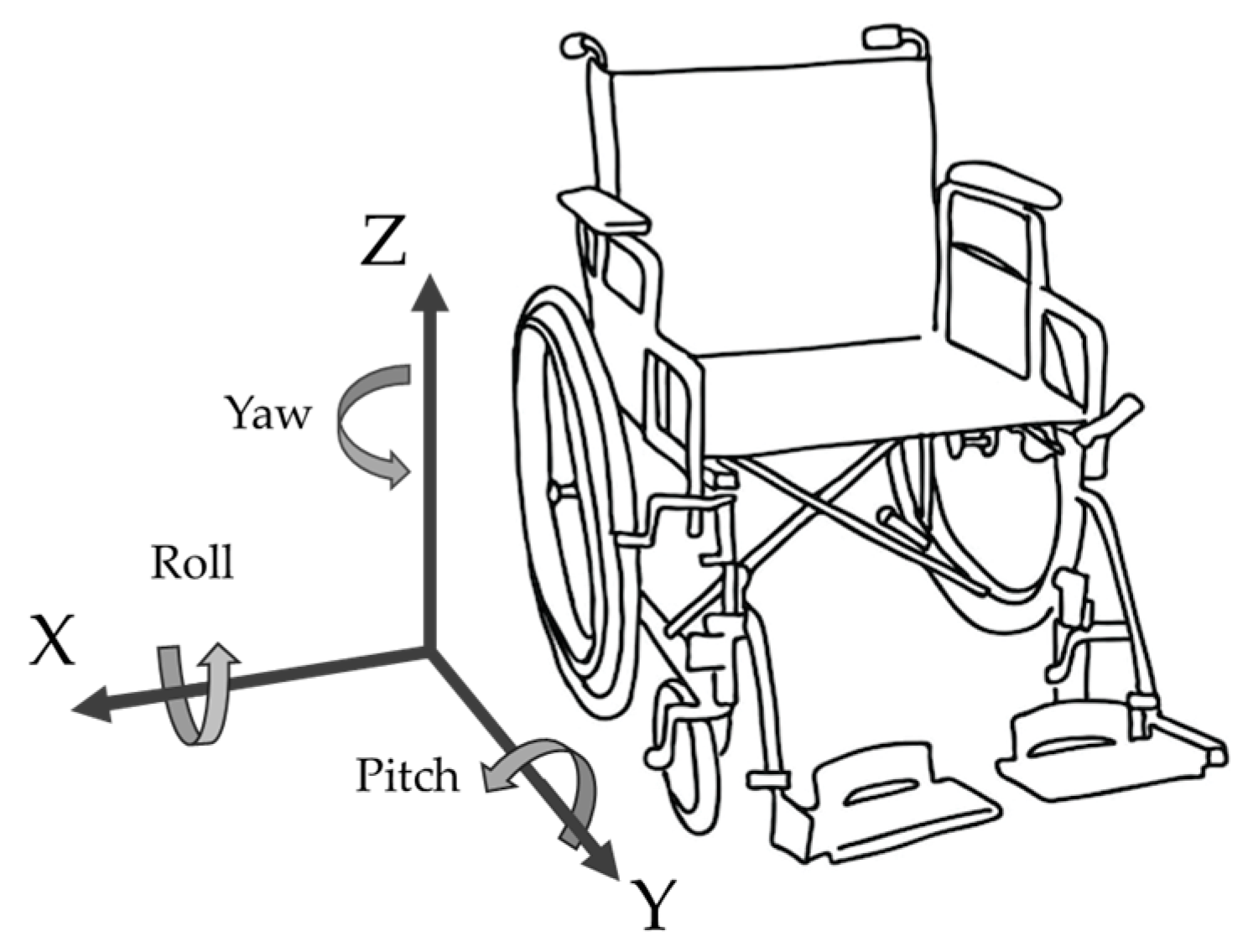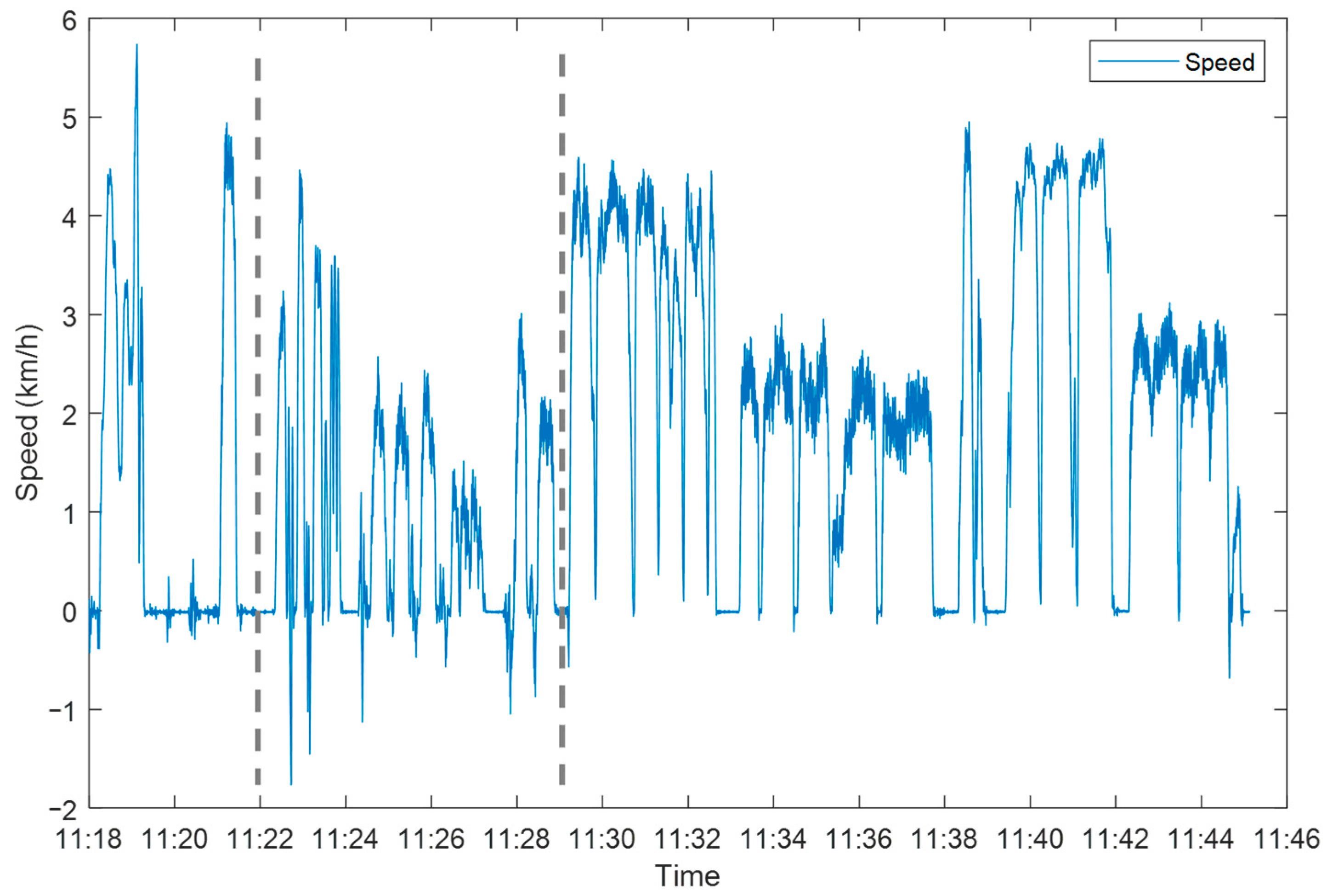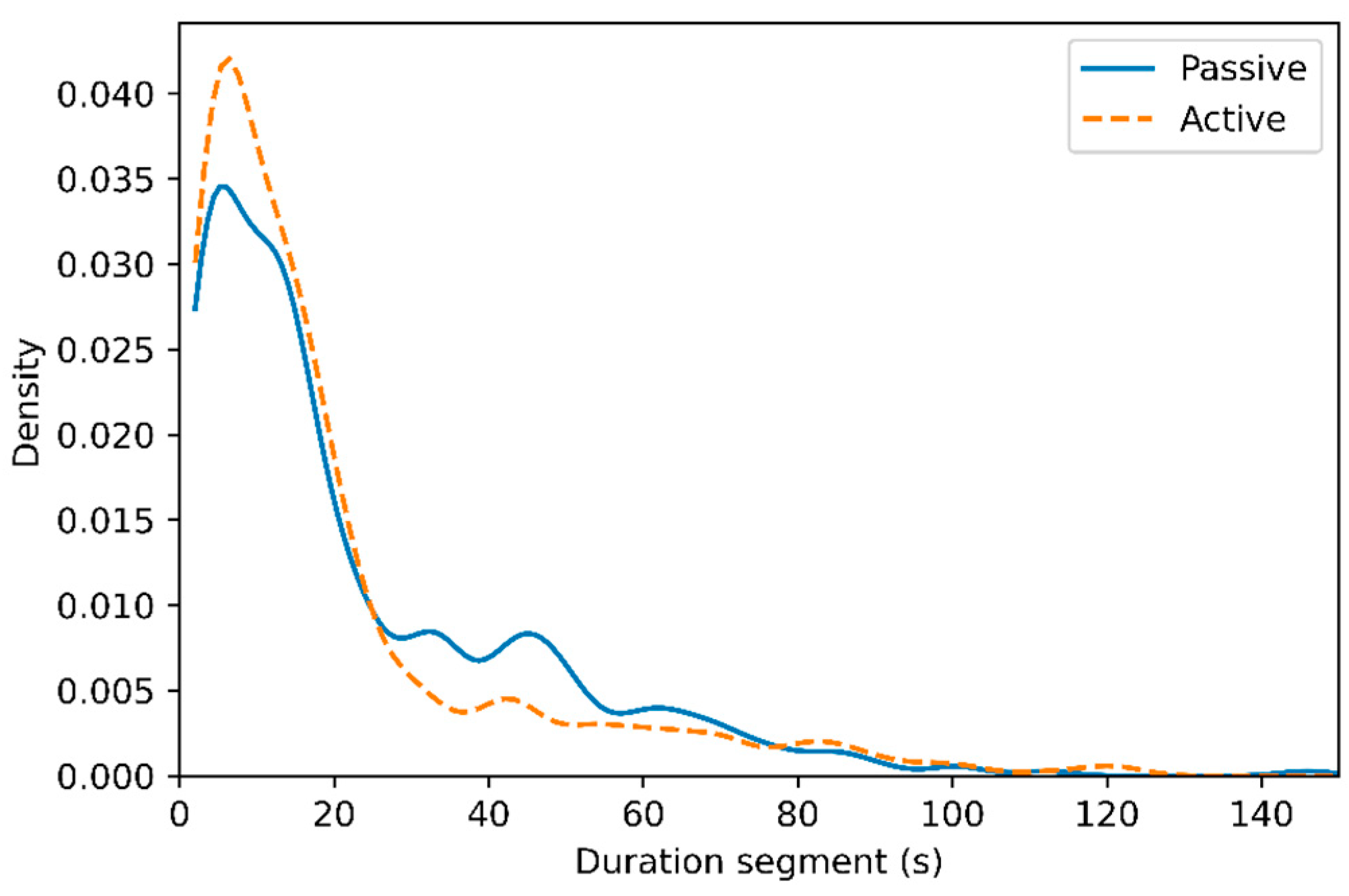The Push Forward in Rehabilitation: Validation of a Machine Learning Method for Detection of Wheelchair Propulsion Type
Abstract
:1. Introduction
2. Materials and Methods
2.1. Design
2.2. Subjects
2.3. Device
2.4. Measurement
2.5. Data Processing
2.6. Performance Analysis
2.7. Machine Learning
3. Results
3.1. Kinematic Data
3.2. Segments
3.3. Classification of Wheelchair Use with Machine Learning
3.4. Feature Importance
4. Discussion
5. Conclusions
Supplementary Materials
Author Contributions
Funding
Institutional Review Board Statement
Informed Consent Statement
Data Availability Statement
Acknowledgments
Conflicts of Interest
References
- Rhodes, R.E.; Janssen, I.; Bredin, S.S.D.; Warburton, D.E.R.; Bauman, A. Physical activity: Health impact, prevalence, correlates and interventions. Psychol. Health 2017, 32, 942–975. [Google Scholar] [CrossRef] [PubMed]
- Ginis, K.A.M.; van der Ploeg, H.P.; Foster, C.; Lai, B.; McBride, C.B.; Ng, K.; Pratt, M.; Shirazipour, C.H.; Smith, B.; Vásquez, P.M.; et al. Participation of people living with disabilities in physical activity: A global perspective. Lancet 2021, 398, 443–455. [Google Scholar] [CrossRef] [PubMed]
- Peiris, C.L.; Taylor, N.F.; Shields, N. Patients receiving inpatient rehabilitation for lower limb orthopaedic conditions do much less physical activity than recommended in guidelines for healthy older adults: An observational study. J. Physiother. 2013, 59, 39–44. [Google Scholar] [CrossRef] [PubMed]
- de Jong, A.U.; Smith, M.; Callisaya, M.L.; Schmidt, M.; Simpson, D.B. Sedentary time and physical activity patterns of stroke survivors during the inpatient rehabilitation week. Int. J. Rehabil. Res. 2021, 44, 131–137. [Google Scholar] [CrossRef]
- Ellapen, T.J.; Hammill, H.V.; Swanepoel, M.; Strydom, G.L. The health benefits and constraints of exercise therapy for wheelchair users: A clinical commentary. Afr. J. Disabil. 2017, 6, 1–8. [Google Scholar] [CrossRef]
- Cowan, R.E.; Silveira, S.L.; Helle, T.; Læssøe, U.; Gøeg, K.R.; Bangshaab, J.; Motl, R.W. Lifestyle physical activity in manual wheelchair users—An overlooked public health opportunity. Spinal Cord 2022, 60, 190–192. [Google Scholar] [CrossRef]
- de Groot, S.; Post, M.W.M.; Bongers-Janssen, H.M.H.; Bloemen-Vrencken, J.H.; van der Woude, L.H.V. Is manual wheelchair satisfaction related to active lifestyle and participation in people with a spinal cord injury? Spinal Cord 2011, 49, 560–565. [Google Scholar] [CrossRef]
- Warms, C.A.; Whitney, J.D.; Belza, B. Measurement and description of physical activity in adult manual wheelchair users. Disabil. Health J. 2008, 1, 236–244. [Google Scholar] [CrossRef]
- Michie, S.; Ashford, S.; Sniehotta, F.F.; Dombrowski, S.U.; Bishop, A.; French, D.P. A refined taxonomy of behaviour change techniques to help people change their physical activity and healthy eating behaviours: The CALO-RE taxonomy. Psychol. Health 2011, 26, 1479–1498. [Google Scholar] [CrossRef]
- Jaarsma, E.A.; Smith, B. Promoting physical activity for disabled people who are ready to become physically active: A systematic review. Psychol. Sport Exerc. 2018, 37, 205–223. [Google Scholar] [CrossRef]
- Popp, W.L.; Brogioli, M.; Leuenberger, K.; Albisser, U.; Frotzler, A.; Curt, A.; Gassert, R.; Starkey, M.L. A novel algorithm for detecting active propulsion in wheelchair users following spinal cord injury. Med. Eng. Phys. 2016, 38, 267–274. [Google Scholar] [CrossRef] [PubMed]
- Lankhorst, K.; Oerbekke, M.; Berg-Emons, R.v.D.; Takken, T.; de Groot, J. Instruments Measuring Physical Activity in Individuals Who Use a Wheelchair: A Systematic Review of Measurement Properties. Arch. Phys. Med. Rehabil. 2020, 101, 535–552. [Google Scholar] [CrossRef] [PubMed]
- Nightingale, T.E.; Rouse, P.C.; Thompson, D.; Bilzon, J.L.J. Measurement of Physical Activity and Energy Expenditure in Wheelchair Users: Methods, Considerations and Future Directions. Sports Med. Open 2017, 3, 10. [Google Scholar] [CrossRef] [PubMed]
- van der Slikke, R.; Berger, M.; Bregman, D.; Lagerberg, A.; Veeger, H. Opportunities for measuring wheelchair kinematics in match settings; reliability of a three inertial sensor configuration. J. Biomech. 2015, 48, 3398–3405. [Google Scholar] [CrossRef]
- Symonds, A.; Holloway, C.; Suzuki, T.; Smitham, P.; Gall, A.; Taylor, S.J. Identifying key experience-related differences in over-ground manual wheelchair propulsion biomechanics. J. Rehabil. Assist. Technol. Eng. 2016, 3, 2055668316678362. [Google Scholar] [CrossRef] [PubMed]
- Montero, I.; León, O.G. A Guide for Naming Research Studies in Psychology. Int. J. Clin. Health Psychol. 2007, 7, 847–862. [Google Scholar]
- Rupf, R.; Tsai, M.; Thomas, S.; Klimstra, M. Original article: Validity of measuring wheelchair kinematics using one inertial measurement unit during commonly used testing protocols in elite wheelchair court sports. J. Biomech. 2021, 127, 110654. [Google Scholar] [CrossRef]
- Van Dijk, M.P.; van der Slikke, R.M.; Rupf, R.; Hoozemans, M.J.; Berger, M.A.; Veeger, D.H. Obtaining wheelchair kinematics with one sensor only? The trade-off between number of inertial sensors and accuracy for measuring wheelchair mobility performance in sports. J. Biomech. 2022, 130, 110879. [Google Scholar] [CrossRef]
- De Leeuw, A.-W.; van der Zwaard, S.; van Baar, R.; Knobbe, A. Personalized machine learning approach to injury monitoring in elite volleyball players. Eur. J. Sport Sci. 2022, 22, 511–520. [Google Scholar] [CrossRef]
- De Leeuw, A.-W.; van Baar, R.; Knobbe, A.; van der Zwaard, S. Modeling Match Performance in Elite Volleyball Players: Importance of Jump Load and Strength Training Characteristics. Sensors 2022, 22, 7996. [Google Scholar] [CrossRef]
- Sokolova, M.; Lapalme, G. A systematic analysis of performance measures for classification tasks. Inf. Process. Manag. 2009, 45, 427–437. [Google Scholar] [CrossRef]
- Cox, D.R. The Regression Analysis of Binary Sequences. J. R. Stat. Soc. Ser. B Methodol. 1958, 20, 215–232. [Google Scholar] [CrossRef]
- Cortes, C.; Vapnik, V. Support-vector networks. Mach. Learn. 1995, 20, 273–297. [Google Scholar] [CrossRef]
- Breiman, L. Random forests. Mach. Learn. 2001, 45, 5–32. [Google Scholar] [CrossRef]
- Webb, G.I.; Keogh, E.; Miikkulainen, R. Naïve Bayes. Enc. Mach. Learn. 2010, 15, 713–714. [Google Scholar]
- Chen, T.; Guestrin, C. XGBoost: A Scalable Tree Boosting System. In Proceedings of the KDD ’16: 22nd ACM SIGKDD International Conference on Knowledge Discovery and Data Mining, San Francisco, CA, USA, 13–17 August 2016; pp. 785–794. [Google Scholar] [CrossRef]
- Dormann, C.F.; Elith, J.; Bacher, S.; Buchmann, C.; Carl, G.; Carré, G.; Marquéz, J.R.G.; Gruber, B.; Lafourcade, B.; Leitão, P.J.; et al. Collinearity: A review of methods to deal with it and a simulation study evaluating their performance. Ecography 2013, 36, 27–46. [Google Scholar] [CrossRef]
- Hastie, T.; Tibshirani, R.; Friedman, J.H.; Friedman, J.H. The Elements of Statistical Learning: Data Mining, Inference, and Prediction; Springer: New York, NY, USA, 2009; Volume 2, pp. 1–758. [Google Scholar]
- Adams, S.A.; Matthews, C.E.; Ebbeling, C.B.; Moore, C.G.; Cunningham, J.E.; Fulton, J.; Hebert, J.R. The Effect of Social Desirability and Social Approval on Self-Reports of Physical Activity. Am. J. Epidemiol. 2005, 161, 389–398. [Google Scholar] [CrossRef]
- Tolerico, M.L.; Ding, D.; Cooper, R.A.; Spaeth, D.M.; Fitzgerald, S.G.; Cooper, R.; Kelleher, A.; Boninger, M.L. Assessing mobility characteristics and activity levels of manual wheelchair users. J. Rehabil. Res. Dev. 2007, 44, 561. [Google Scholar] [CrossRef]
- Leving, M.T.; Horemans, H.L.D.; Vegter, R.J.K.; de Groot, S.; Bussmann, J.B.J.; van der Woude, L.H.V. Validity of consumer-grade activity monitor to identify manual wheelchair propulsion in standardized activities of daily living. PLoS ONE 2018, 13, e0194864. [Google Scholar] [CrossRef]
- Hiremath, S.V.; Intille, S.S.; Kelleher, A.; Cooper, R.A.; Ding, D. Detection of physical activities using a physical activity monitor system for wheelchair users. Med. Eng. Phys. 2015, 37, 68–76. [Google Scholar] [CrossRef]
- Postma, K.; van Den, H.J.G.B.-E.; Bussmann, J.B.J.; Sluis, T.A.R.; Bergen, M.P.; Stam, H.J. Validity of the detection of wheelchair propulsion as measured with an Activity Monitor in patients with spinal cord injury. Spinal Cord 2005, 43, 550–557. [Google Scholar] [CrossRef] [PubMed]






| Accuracy | Precision | Recall | F1 Score | |
|---|---|---|---|---|
| Wheel model (S1) | 0.805 | 0.836 | 0.819 | 0.827 |
| Full model (S2) | 0.873 | 0.888 | 0.886 | 0.886 |
| Predictor Variable | Importance Score | Correlation Target |
|---|---|---|
| Median angular acceleration around the roll axis | 0.06 | − |
| Median angular velocity around the roll axis | 0.06 | − |
| Standard deviation linear acceleration | 0.05 | + |
| Standard dev. amplitudes of Fourier series for linear speed | 0.05 | − |
| Kurtosis angular velocity y-component of wheel sensor | 0.05 | + |
Disclaimer/Publisher’s Note: The statements, opinions and data contained in all publications are solely those of the individual author(s) and contributor(s) and not of MDPI and/or the editor(s). MDPI and/or the editor(s) disclaim responsibility for any injury to people or property resulting from any ideas, methods, instructions or products referred to in the content. |
© 2024 by the authors. Licensee MDPI, Basel, Switzerland. This article is an open access article distributed under the terms and conditions of the Creative Commons Attribution (CC BY) license (https://creativecommons.org/licenses/by/4.0/).
Share and Cite
van der Slikke, R.; de Leeuw, A.-W.; de Rooij, A.; Berger, M. The Push Forward in Rehabilitation: Validation of a Machine Learning Method for Detection of Wheelchair Propulsion Type. Sensors 2024, 24, 657. https://doi.org/10.3390/s24020657
van der Slikke R, de Leeuw A-W, de Rooij A, Berger M. The Push Forward in Rehabilitation: Validation of a Machine Learning Method for Detection of Wheelchair Propulsion Type. Sensors. 2024; 24(2):657. https://doi.org/10.3390/s24020657
Chicago/Turabian Stylevan der Slikke, Rienk, Arie-Willem de Leeuw, Aleid de Rooij, and Monique Berger. 2024. "The Push Forward in Rehabilitation: Validation of a Machine Learning Method for Detection of Wheelchair Propulsion Type" Sensors 24, no. 2: 657. https://doi.org/10.3390/s24020657







